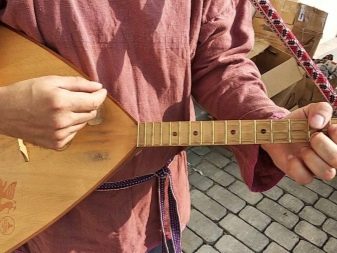Features of the prima balalaika

Balalaika is a symbol of Russian folk musical culture. Its name supposedly means "joking", "talking". Indeed, this seemingly simple instrument is capable of conveying a whole gamut of feelings: from fun to sadness.


What it is?
There are several types of balalaika. Among them, the most famous is the prima balalaika. Its creator is V. Andreev. He transformed the folk instrument, gave it a modern dimension and improved its shape, achieving a deeper sound.
This name - prima - balalaika received quite deservedly. In her family, she is the leading, soloist. She is subject to the most complex works that require high technique in the performance of the work.
The dimensions of this tool range from 600 to 700 mm. The triangular body is not one-piece, it consists of 6 or 7 elements. Made of wood, usually beech. The deck (upper part of the body) is made of softwood, for example, spruce. The deck serves as a resonator that adds depth to the sound.
The neck is slightly bent back, includes from 16 to 31 frets.


The balalaika has three strings, most often metal. Two strings used to be made from veins, but now they are made from nylon or carbon. According to its characteristics, the balalaika is not inferior to symphonic instruments. The range of its sounding is from "mi" of the first octave to "to" of the fourth.
The merit of V. Andreev lies in the fact that he introduced the balalaika system, which is usually called academic. For the prima, it is as follows: "mi", "mi", "la" of the first octave.

Balalaikas are of different types depending on the purpose. There are student ones, which are used by those who are just mastering the subtleties of playing this instrument. Professional balalaika players play a concert balalaika.It is a tool created from precious woods, tuned and fine-tuned by craftsmen. It is intended, according to the name, for academic performances.
Concert balalaikas can be of factory or artisan performance. The latter are more highly valued, since they have a unique sound. They are divided into several categories: 3, 2, 1 and the highest.
The category depends on how valuable the wood was used in the manufacture. The material can be beech, pear, maple.


Components and accessories
For all its simplicity, the balalaika is an instrument of a rather complex structure. The service life of the instrument and its sound depend on how high-quality parts are used in it. Some of the elements need regular replacement and adjustment.
The strings determine the clarity and timbre of the balalaika. Strings that are too thin create a rattling sound, too thick strings make sound production heavy, diminish the melodiousness, and can also break.
The tuning mechanism is located on the paddle that ends the neck and is used to stretch the strings. It needs to be changed from time to time, as the tuners wear out and do not allow you to maintain a high quality of the game.

The string stand adjusts the quality and strength of the sound. Maple is the best material for making it. The bottom of the stand should fit snugly against the deck. In this case, there will be no rattling sound. The sound of the instrument, as well as the convenience of playing on it, depends on the height and correct position of the stand.
The selection of accessories is also important. The shoulder strap will help to relieve tension in the hands, especially when the musician is standing or moving while performing a piece.
The balalaika, like any musical instrument, requires careful maintenance. Therefore, a cover will become a necessary purchase. It will help keep the tool free from dust, dirt and moisture.


Tips for setting
Balalaika tuning is not very difficult, especially if the instrument is used only for playing music at home. The first string is tuned to the note "A", and the second and third to the note "E". You can tune the instrument by ear or check the accuracy of the adjustment with a piano. The check is carried out in this way: after tuning, leave the lower string free, and press the upper two to the fifth fret. All three strings should sound in unison.
When you need to tune a concert instrument, you need to take it more seriously. To create the correct sound of the strings, you need to use a tuner, button accordion or piano. Of great importance is also how well the strings are tightened. Their service life depends on this. And also it will allow you to avoid troubles during the concert.
Having begun its history several centuries ago, the balalaika remains a favorite and famous instrument. It captivates and captivates with its sound both folk holidays and academic venues.

Tips for choosing a balalaika in a video.








